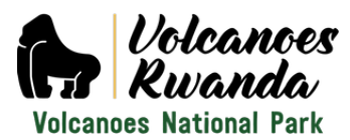Volcanoes National Park (PNV) covers 160 sq km in northern Rwanda and Mountain gorillas roam the bamboo and tropical forested volcanoes as the main tourist attractions. About 200 individuals thrive as part of the greater Virunga Conservation Area, 10 gorilla families have been habituated which can be seen by travelers on a gorilla safari to Rwanda. Gorillas are seen stunning themselves, feeding on bamboo in the mornings during a guided trek with Rwandan Development Board guides.
Mountain gorillas are the animals on the mind of every wildlife enthusiast and adventure lover visiting Rwanda on a holiday. What has made gorilla trekking safaris special since 1999 is tight security, strong eco-tourism rules and our attention to detail when it comes to planning for our visitor’s gorilla safari.
As a rule of the thumb, you can visit Rwanda any time of the year as well as mountain gorilla trekking goes on year round too. Seeing gorillas in Rwanda becomes easier in the dry seasons, from December to February and another June to September. There’s less rain during these months, but the rainforest ground is ever wet due to equatorial climate and weather. It’s obvious even when its dry period hiking to the gorillas requires fitness due to steep altitude volcanoes.
However, the dominant bamboo forests where gorillas feed and stay most of the time, has less thick undergrowth, trails are fairly dry. With help of rangers and guides you’re guaranteed to see gorillas. The bamboo vegetation also presents clear viewing and great photography; I guess you’d love to share on social media showing friends how close you were with your cousins
When Is the Best Time to Go Gorilla Trekking
Gorilla trekking in Rwanda can be done all year round but the best time to see mountain gorillas in their natural habitat is during the dry season from mid December to early February and June to September. There’s less difficult in hiking since trails tend to be quite dry and also the risk of malaria is low due to hot sunny weather conditions. However, trekkers should carry insect repellants during treks.
Gorillas are predominantly ground dwelling but during fruiting season, female gorillas tend to climb higher in tree canopies.
Trekking trails go through thick vegetation cover hence you should have sturdy hiking boots, long pants and warm sleeved shirts, gloves and rain jackets. Gorillas like to spend most of their time foraging on bamboo at higher altitudes between 2,400 to 3,000 meters above sea level. This means that gorillas during the dry season tend to move for long distances in search of fresh vegetation which can make treks longer hence it’s better to be physically fit and hire a porter.
During the dry months, Volcanoes National Park receives many tourists who want to see gorillas which puts a high competition and demand for gorilla permits. Visitors must therefore try and secure a gorilla permit by booking with a tour operator or the Rwandan Development Board in advance time of 2-3 months. Likewise the availability of accommodation tend to be scarce due to many tourists which requires you to book for one earlier.
In dry season the tropical highland weather is favorable with sunny weather and fewer insects such as mosquitoes and wasps. It’s easier getting to gorillas and come back without malaria illness development. Nevertheless, you need to have insect repellants and waterproof gears; to prepare, for it can rain any time of the day especially when gorillas are located above 3,000 meters above sea level.
On the other hand, the wet season in Rwanda begins in March to May with heavy rains and ends in November with fewer rains. You can also track gorillas during these months despite the difficulty associated with hiking on muddy and slippery trails. Hiking gears such as clothing should bear nature friendly colors such as green, grey or black.
The rainy season from April to May with heavy and fewer rains in October to November could be great time to see gorillas depending on someone’s preferences.
Because tourists for gorilla trekking in Rwanda become fewer, there is low demand for gorilla permits which makes it easier to book. This means that the availability of accommodations is higher in all ranges from high end to budget lodgings within and around volcanoes national park. Generally, evenings get colder you may need to choose accommodations with campfire places or provide traditional Colobus with hot water to warm up your bed.
Though most tourists tend to avoid the wet season, there’s a possibility of shorter treks because gorillas like foliage on lower slopes most of the time due to abundance of vegetation which is food for gorillas. In addition, the bamboo vegetation is not thick which guarantees perfect gorilla views and photographs.
The rainy seasons are preferred for their advantages including fewer crowds, discount accommodation rooms, even though gorilla permit price in Rwanda never changes. As many try to avoid holidays to Rwanda including gorilla trekking safari during rains, the gorilla safari won’t be expensive like that of the peak seasons.
It does not rain all day or night long, the vegetation gets greener with colorful flowering plants and gorillas like to feed in short ranges or closer to the park boundaries due to abundance of food and relatively warmer weather than on higher slopes of the volcanoes.
Regardless of the seasons one intends to track mountain gorillas, the best time to trek gorillas in Rwanda is during the dry season in December, February, June and September.
Important Things to Know
On the day of trekking, early morning you set off from Kingi, the main gorilla trekking center, there’s no specific time when you will reach the gorillas. Even though it’s guaranteed with trackers and guides, visitors are kindly requested to always reveal their fitness capacity to the guides to be allocated to gorillas that like to feed on lower slopes or near the park boundary and easy to reach.
